Approaches to Nursing: Module 3 - Ethics, Consent, Governance Overview
VerifiedAdded on 2022/11/21
|12
|4776
|3
Homework Assignment
AI Summary
This assignment provides a detailed exploration of key ethical and legal considerations within nursing practice. It covers Module 3 of the 401007 Approaches to Professional Nursing Practice course, focusing on NMBA documents, ethics, consent, and professional governance. The assignment delves into bioethics, confidentiality, and legal principles related to informed consent, including assault and battery. It examines the factors influencing informed consent, such as the nature of information, treatment, patient desires, temperament, and circumstances. The document also addresses professional governance, including codes of ethics, professional conduct, guidelines, and competency standards. It further explores administrative law, professional discipline, and the role of regulatory bodies like AHPRA. The importance of professional reasoning, documentation, and adherence to ethical standards is highlighted, with an emphasis on protecting patient rights and minimizing legal risks. The concepts of implied, verbal, and written consent are also explained.
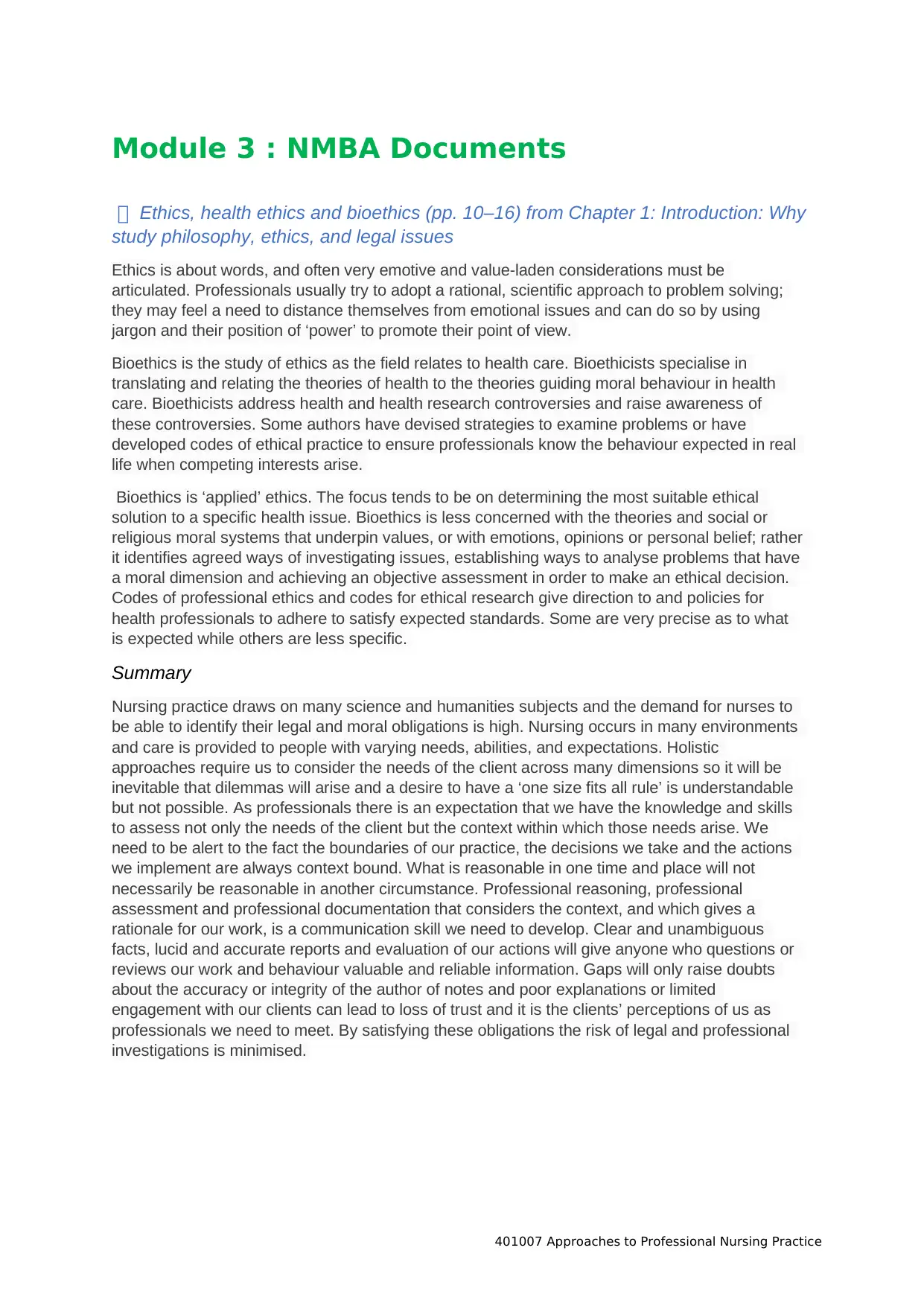
401007 Approaches to Professional Nursing Practice
Module 3 : NMBA Documents
Ethics, health ethics and bioethics (pp. 10–16) from Chapter 1: Introduction: Why
study philosophy, ethics, and legal issues
Ethics is about words, and often very emotive and value-laden considerations must be
articulated. Professionals usually try to adopt a rational, scientific approach to problem solving;
they may feel a need to distance themselves from emotional issues and can do so by using
jargon and their position of ‘power’ to promote their point of view.
Bioethics is the study of ethics as the field relates to health care. Bioethicists specialise in
translating and relating the theories of health to the theories guiding moral behaviour in health
care. Bioethicists address health and health research controversies and raise awareness of
these controversies. Some authors have devised strategies to examine problems or have
developed codes of ethical practice to ensure professionals know the behaviour expected in real
life when competing interests arise.
Bioethics is ‘applied’ ethics. The focus tends to be on determining the most suitable ethical
solution to a specific health issue. Bioethics is less concerned with the theories and social or
religious moral systems that underpin values, or with emotions, opinions or personal belief; rather
it identifies agreed ways of investigating issues, establishing ways to analyse problems that have
a moral dimension and achieving an objective assessment in order to make an ethical decision.
Codes of professional ethics and codes for ethical research give direction to and policies for
health professionals to adhere to satisfy expected standards. Some are very precise as to what
is expected while others are less specific.
Summary
Nursing practice draws on many science and humanities subjects and the demand for nurses to
be able to identify their legal and moral obligations is high. Nursing occurs in many environments
and care is provided to people with varying needs, abilities, and expectations. Holistic
approaches require us to consider the needs of the client across many dimensions so it will be
inevitable that dilemmas will arise and a desire to have a ‘one size fits all rule’ is understandable
but not possible. As professionals there is an expectation that we have the knowledge and skills
to assess not only the needs of the client but the context within which those needs arise. We
need to be alert to the fact the boundaries of our practice, the decisions we take and the actions
we implement are always context bound. What is reasonable in one time and place will not
necessarily be reasonable in another circumstance. Professional reasoning, professional
assessment and professional documentation that considers the context, and which gives a
rationale for our work, is a communication skill we need to develop. Clear and unambiguous
facts, lucid and accurate reports and evaluation of our actions will give anyone who questions or
reviews our work and behaviour valuable and reliable information. Gaps will only raise doubts
about the accuracy or integrity of the author of notes and poor explanations or limited
engagement with our clients can lead to loss of trust and it is the clients’ perceptions of us as
professionals we need to meet. By satisfying these obligations the risk of legal and professional
investigations is minimised.
Module 3 : NMBA Documents
Ethics, health ethics and bioethics (pp. 10–16) from Chapter 1: Introduction: Why
study philosophy, ethics, and legal issues
Ethics is about words, and often very emotive and value-laden considerations must be
articulated. Professionals usually try to adopt a rational, scientific approach to problem solving;
they may feel a need to distance themselves from emotional issues and can do so by using
jargon and their position of ‘power’ to promote their point of view.
Bioethics is the study of ethics as the field relates to health care. Bioethicists specialise in
translating and relating the theories of health to the theories guiding moral behaviour in health
care. Bioethicists address health and health research controversies and raise awareness of
these controversies. Some authors have devised strategies to examine problems or have
developed codes of ethical practice to ensure professionals know the behaviour expected in real
life when competing interests arise.
Bioethics is ‘applied’ ethics. The focus tends to be on determining the most suitable ethical
solution to a specific health issue. Bioethics is less concerned with the theories and social or
religious moral systems that underpin values, or with emotions, opinions or personal belief; rather
it identifies agreed ways of investigating issues, establishing ways to analyse problems that have
a moral dimension and achieving an objective assessment in order to make an ethical decision.
Codes of professional ethics and codes for ethical research give direction to and policies for
health professionals to adhere to satisfy expected standards. Some are very precise as to what
is expected while others are less specific.
Summary
Nursing practice draws on many science and humanities subjects and the demand for nurses to
be able to identify their legal and moral obligations is high. Nursing occurs in many environments
and care is provided to people with varying needs, abilities, and expectations. Holistic
approaches require us to consider the needs of the client across many dimensions so it will be
inevitable that dilemmas will arise and a desire to have a ‘one size fits all rule’ is understandable
but not possible. As professionals there is an expectation that we have the knowledge and skills
to assess not only the needs of the client but the context within which those needs arise. We
need to be alert to the fact the boundaries of our practice, the decisions we take and the actions
we implement are always context bound. What is reasonable in one time and place will not
necessarily be reasonable in another circumstance. Professional reasoning, professional
assessment and professional documentation that considers the context, and which gives a
rationale for our work, is a communication skill we need to develop. Clear and unambiguous
facts, lucid and accurate reports and evaluation of our actions will give anyone who questions or
reviews our work and behaviour valuable and reliable information. Gaps will only raise doubts
about the accuracy or integrity of the author of notes and poor explanations or limited
engagement with our clients can lead to loss of trust and it is the clients’ perceptions of us as
professionals we need to meet. By satisfying these obligations the risk of legal and professional
investigations is minimised.
Paraphrase This Document
Need a fresh take? Get an instant paraphrase of this document with our AI Paraphraser
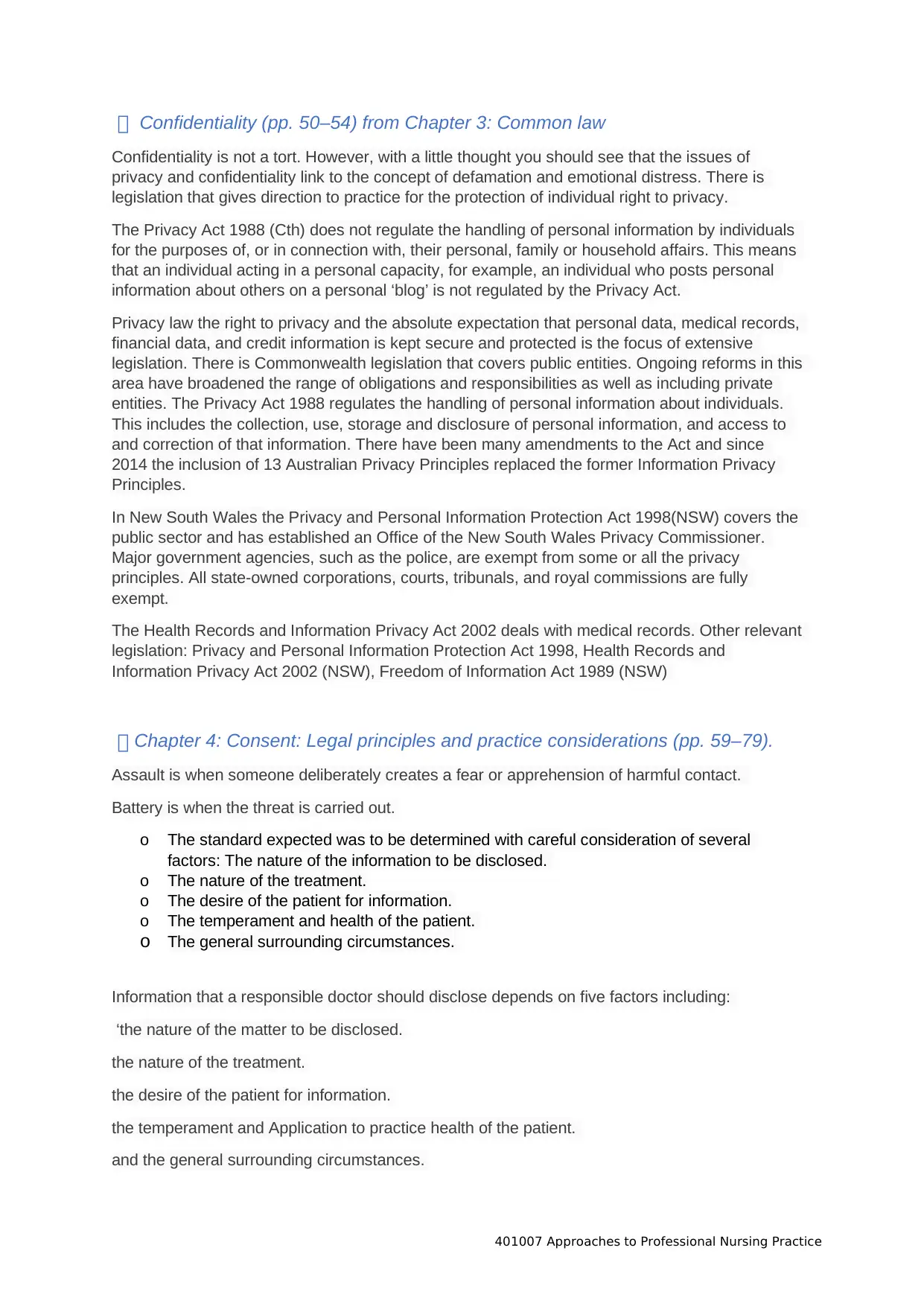
401007 Approaches to Professional Nursing Practice
Confidentiality (pp. 50–54) from Chapter 3: Common law
Confidentiality is not a tort. However, with a little thought you should see that the issues of
privacy and confidentiality link to the concept of defamation and emotional distress. There is
legislation that gives direction to practice for the protection of individual right to privacy.
The Privacy Act 1988 (Cth) does not regulate the handling of personal information by individuals
for the purposes of, or in connection with, their personal, family or household affairs. This means
that an individual acting in a personal capacity, for example, an individual who posts personal
information about others on a personal ‘blog’ is not regulated by the Privacy Act.
Privacy law the right to privacy and the absolute expectation that personal data, medical records,
financial data, and credit information is kept secure and protected is the focus of extensive
legislation. There is Commonwealth legislation that covers public entities. Ongoing reforms in this
area have broadened the range of obligations and responsibilities as well as including private
entities. The Privacy Act 1988 regulates the handling of personal information about individuals.
This includes the collection, use, storage and disclosure of personal information, and access to
and correction of that information. There have been many amendments to the Act and since
2014 the inclusion of 13 Australian Privacy Principles replaced the former Information Privacy
Principles.
In New South Wales the Privacy and Personal Information Protection Act 1998(NSW) covers the
public sector and has established an Office of the New South Wales Privacy Commissioner.
Major government agencies, such as the police, are exempt from some or all the privacy
principles. All state-owned corporations, courts, tribunals, and royal commissions are fully
exempt.
The Health Records and Information Privacy Act 2002 deals with medical records. Other relevant
legislation: Privacy and Personal Information Protection Act 1998, Health Records and
Information Privacy Act 2002 (NSW), Freedom of Information Act 1989 (NSW)
Chapter 4: Consent: Legal principles and practice considerations (pp. 59–79).
Assault is when someone deliberately creates a fear or apprehension of harmful contact.
Battery is when the threat is carried out.
o The standard expected was to be determined with careful consideration of several
factors: The nature of the information to be disclosed.
o The nature of the treatment.
o The desire of the patient for information.
o The temperament and health of the patient.
o The general surrounding circumstances.
Information that a responsible doctor should disclose depends on five factors including:
‘the nature of the matter to be disclosed.
the nature of the treatment.
the desire of the patient for information.
the temperament and Application to practice health of the patient.
and the general surrounding circumstances.
Confidentiality (pp. 50–54) from Chapter 3: Common law
Confidentiality is not a tort. However, with a little thought you should see that the issues of
privacy and confidentiality link to the concept of defamation and emotional distress. There is
legislation that gives direction to practice for the protection of individual right to privacy.
The Privacy Act 1988 (Cth) does not regulate the handling of personal information by individuals
for the purposes of, or in connection with, their personal, family or household affairs. This means
that an individual acting in a personal capacity, for example, an individual who posts personal
information about others on a personal ‘blog’ is not regulated by the Privacy Act.
Privacy law the right to privacy and the absolute expectation that personal data, medical records,
financial data, and credit information is kept secure and protected is the focus of extensive
legislation. There is Commonwealth legislation that covers public entities. Ongoing reforms in this
area have broadened the range of obligations and responsibilities as well as including private
entities. The Privacy Act 1988 regulates the handling of personal information about individuals.
This includes the collection, use, storage and disclosure of personal information, and access to
and correction of that information. There have been many amendments to the Act and since
2014 the inclusion of 13 Australian Privacy Principles replaced the former Information Privacy
Principles.
In New South Wales the Privacy and Personal Information Protection Act 1998(NSW) covers the
public sector and has established an Office of the New South Wales Privacy Commissioner.
Major government agencies, such as the police, are exempt from some or all the privacy
principles. All state-owned corporations, courts, tribunals, and royal commissions are fully
exempt.
The Health Records and Information Privacy Act 2002 deals with medical records. Other relevant
legislation: Privacy and Personal Information Protection Act 1998, Health Records and
Information Privacy Act 2002 (NSW), Freedom of Information Act 1989 (NSW)
Chapter 4: Consent: Legal principles and practice considerations (pp. 59–79).
Assault is when someone deliberately creates a fear or apprehension of harmful contact.
Battery is when the threat is carried out.
o The standard expected was to be determined with careful consideration of several
factors: The nature of the information to be disclosed.
o The nature of the treatment.
o The desire of the patient for information.
o The temperament and health of the patient.
o The general surrounding circumstances.
Information that a responsible doctor should disclose depends on five factors including:
‘the nature of the matter to be disclosed.
the nature of the treatment.
the desire of the patient for information.
the temperament and Application to practice health of the patient.
and the general surrounding circumstances.
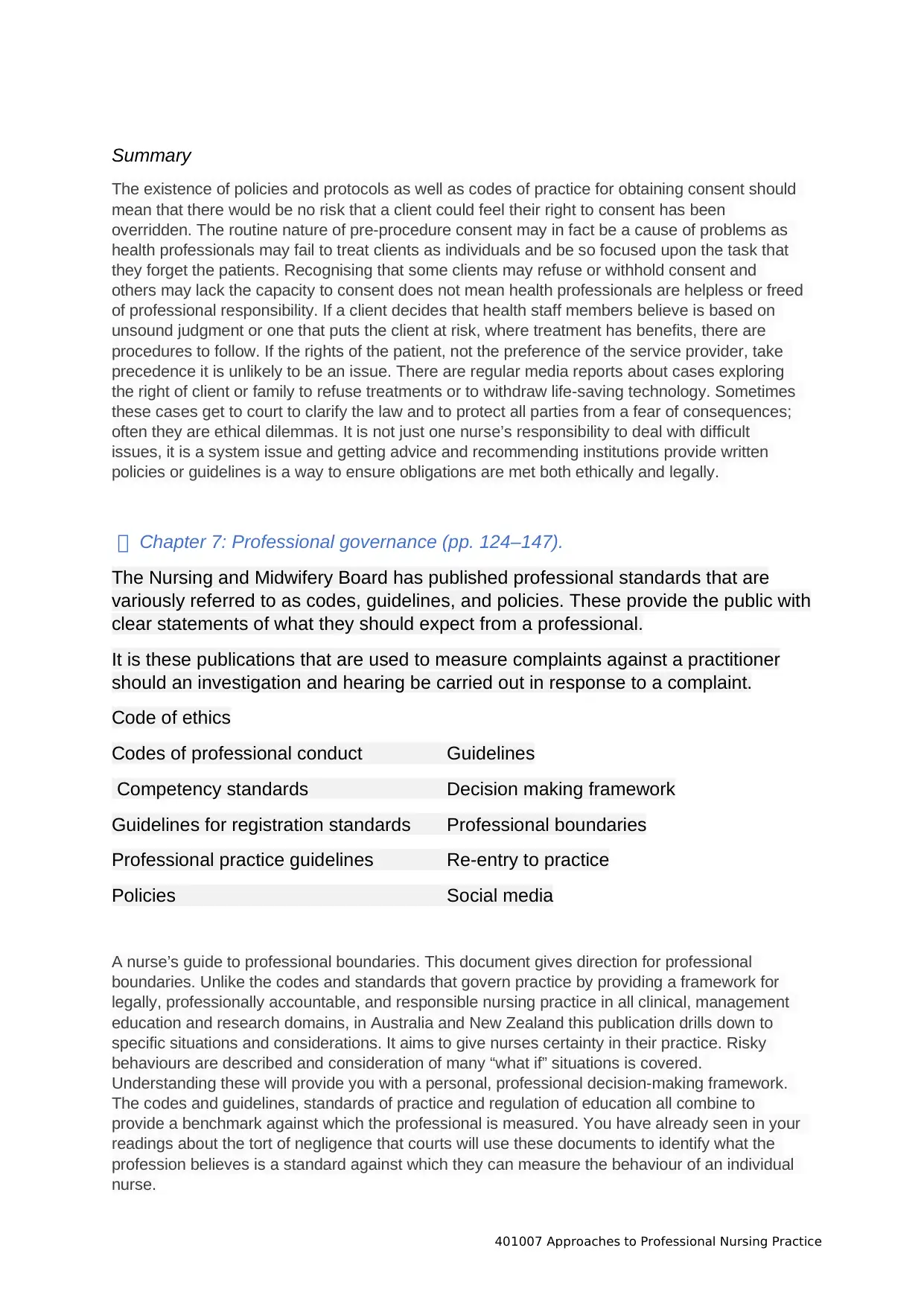
401007 Approaches to Professional Nursing Practice
Summary
The existence of policies and protocols as well as codes of practice for obtaining consent should
mean that there would be no risk that a client could feel their right to consent has been
overridden. The routine nature of pre-procedure consent may in fact be a cause of problems as
health professionals may fail to treat clients as individuals and be so focused upon the task that
they forget the patients. Recognising that some clients may refuse or withhold consent and
others may lack the capacity to consent does not mean health professionals are helpless or freed
of professional responsibility. If a client decides that health staff members believe is based on
unsound judgment or one that puts the client at risk, where treatment has benefits, there are
procedures to follow. If the rights of the patient, not the preference of the service provider, take
precedence it is unlikely to be an issue. There are regular media reports about cases exploring
the right of client or family to refuse treatments or to withdraw life-saving technology. Sometimes
these cases get to court to clarify the law and to protect all parties from a fear of consequences;
often they are ethical dilemmas. It is not just one nurse’s responsibility to deal with difficult
issues, it is a system issue and getting advice and recommending institutions provide written
policies or guidelines is a way to ensure obligations are met both ethically and legally.
Chapter 7: Professional governance (pp. 124–147).
The Nursing and Midwifery Board has published professional standards that are
variously referred to as codes, guidelines, and policies. These provide the public with
clear statements of what they should expect from a professional.
It is these publications that are used to measure complaints against a practitioner
should an investigation and hearing be carried out in response to a complaint.
Code of ethics
Codes of professional conduct Guidelines
Competency standards Decision making framework
Guidelines for registration standards Professional boundaries
Professional practice guidelines Re-entry to practice
Policies Social media
A nurse’s guide to professional boundaries. This document gives direction for professional
boundaries. Unlike the codes and standards that govern practice by providing a framework for
legally, professionally accountable, and responsible nursing practice in all clinical, management
education and research domains, in Australia and New Zealand this publication drills down to
specific situations and considerations. It aims to give nurses certainty in their practice. Risky
behaviours are described and consideration of many “what if” situations is covered.
Understanding these will provide you with a personal, professional decision-making framework.
The codes and guidelines, standards of practice and regulation of education all combine to
provide a benchmark against which the professional is measured. You have already seen in your
readings about the tort of negligence that courts will use these documents to identify what the
profession believes is a standard against which they can measure the behaviour of an individual
nurse.
Summary
The existence of policies and protocols as well as codes of practice for obtaining consent should
mean that there would be no risk that a client could feel their right to consent has been
overridden. The routine nature of pre-procedure consent may in fact be a cause of problems as
health professionals may fail to treat clients as individuals and be so focused upon the task that
they forget the patients. Recognising that some clients may refuse or withhold consent and
others may lack the capacity to consent does not mean health professionals are helpless or freed
of professional responsibility. If a client decides that health staff members believe is based on
unsound judgment or one that puts the client at risk, where treatment has benefits, there are
procedures to follow. If the rights of the patient, not the preference of the service provider, take
precedence it is unlikely to be an issue. There are regular media reports about cases exploring
the right of client or family to refuse treatments or to withdraw life-saving technology. Sometimes
these cases get to court to clarify the law and to protect all parties from a fear of consequences;
often they are ethical dilemmas. It is not just one nurse’s responsibility to deal with difficult
issues, it is a system issue and getting advice and recommending institutions provide written
policies or guidelines is a way to ensure obligations are met both ethically and legally.
Chapter 7: Professional governance (pp. 124–147).
The Nursing and Midwifery Board has published professional standards that are
variously referred to as codes, guidelines, and policies. These provide the public with
clear statements of what they should expect from a professional.
It is these publications that are used to measure complaints against a practitioner
should an investigation and hearing be carried out in response to a complaint.
Code of ethics
Codes of professional conduct Guidelines
Competency standards Decision making framework
Guidelines for registration standards Professional boundaries
Professional practice guidelines Re-entry to practice
Policies Social media
A nurse’s guide to professional boundaries. This document gives direction for professional
boundaries. Unlike the codes and standards that govern practice by providing a framework for
legally, professionally accountable, and responsible nursing practice in all clinical, management
education and research domains, in Australia and New Zealand this publication drills down to
specific situations and considerations. It aims to give nurses certainty in their practice. Risky
behaviours are described and consideration of many “what if” situations is covered.
Understanding these will provide you with a personal, professional decision-making framework.
The codes and guidelines, standards of practice and regulation of education all combine to
provide a benchmark against which the professional is measured. You have already seen in your
readings about the tort of negligence that courts will use these documents to identify what the
profession believes is a standard against which they can measure the behaviour of an individual
nurse.
⊘ This is a preview!⊘
Do you want full access?
Subscribe today to unlock all pages.

Trusted by 1+ million students worldwide
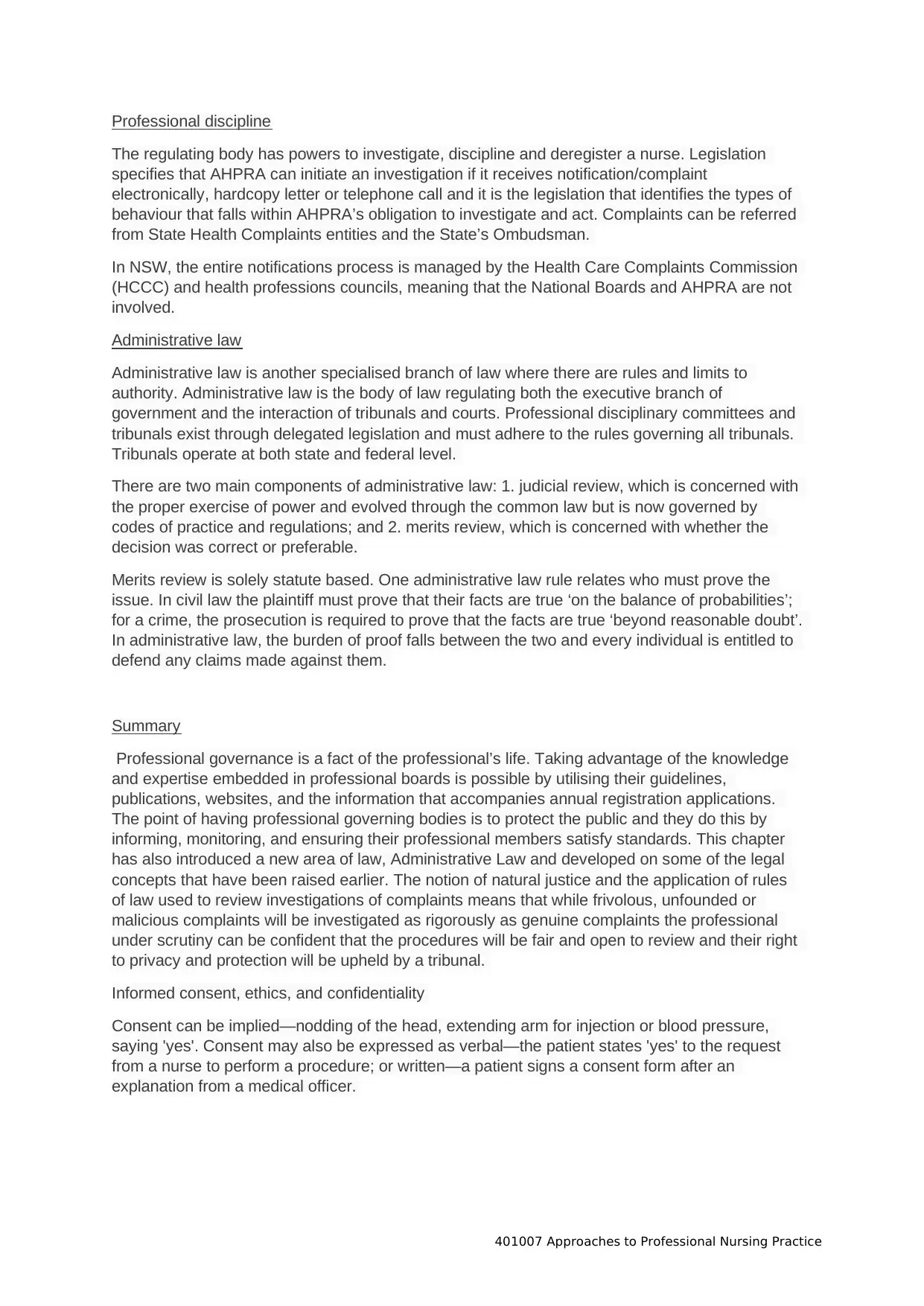
401007 Approaches to Professional Nursing Practice
Professional discipline
The regulating body has powers to investigate, discipline and deregister a nurse. Legislation
specifies that AHPRA can initiate an investigation if it receives notification/complaint
electronically, hardcopy letter or telephone call and it is the legislation that identifies the types of
behaviour that falls within AHPRA’s obligation to investigate and act. Complaints can be referred
from State Health Complaints entities and the State’s Ombudsman.
In NSW, the entire notifications process is managed by the Health Care Complaints Commission
(HCCC) and health professions councils, meaning that the National Boards and AHPRA are not
involved.
Administrative law
Administrative law is another specialised branch of law where there are rules and limits to
authority. Administrative law is the body of law regulating both the executive branch of
government and the interaction of tribunals and courts. Professional disciplinary committees and
tribunals exist through delegated legislation and must adhere to the rules governing all tribunals.
Tribunals operate at both state and federal level.
There are two main components of administrative law: 1. judicial review, which is concerned with
the proper exercise of power and evolved through the common law but is now governed by
codes of practice and regulations; and 2. merits review, which is concerned with whether the
decision was correct or preferable.
Merits review is solely statute based. One administrative law rule relates who must prove the
issue. In civil law the plaintiff must prove that their facts are true ‘on the balance of probabilities’;
for a crime, the prosecution is required to prove that the facts are true ‘beyond reasonable doubt’.
In administrative law, the burden of proof falls between the two and every individual is entitled to
defend any claims made against them.
Summary
Professional governance is a fact of the professional’s life. Taking advantage of the knowledge
and expertise embedded in professional boards is possible by utilising their guidelines,
publications, websites, and the information that accompanies annual registration applications.
The point of having professional governing bodies is to protect the public and they do this by
informing, monitoring, and ensuring their professional members satisfy standards. This chapter
has also introduced a new area of law, Administrative Law and developed on some of the legal
concepts that have been raised earlier. The notion of natural justice and the application of rules
of law used to review investigations of complaints means that while frivolous, unfounded or
malicious complaints will be investigated as rigorously as genuine complaints the professional
under scrutiny can be confident that the procedures will be fair and open to review and their right
to privacy and protection will be upheld by a tribunal.
Informed consent, ethics, and confidentiality
Consent can be implied—nodding of the head, extending arm for injection or blood pressure,
saying 'yes'. Consent may also be expressed as verbal—the patient states 'yes' to the request
from a nurse to perform a procedure; or written—a patient signs a consent form after an
explanation from a medical officer.
Professional discipline
The regulating body has powers to investigate, discipline and deregister a nurse. Legislation
specifies that AHPRA can initiate an investigation if it receives notification/complaint
electronically, hardcopy letter or telephone call and it is the legislation that identifies the types of
behaviour that falls within AHPRA’s obligation to investigate and act. Complaints can be referred
from State Health Complaints entities and the State’s Ombudsman.
In NSW, the entire notifications process is managed by the Health Care Complaints Commission
(HCCC) and health professions councils, meaning that the National Boards and AHPRA are not
involved.
Administrative law
Administrative law is another specialised branch of law where there are rules and limits to
authority. Administrative law is the body of law regulating both the executive branch of
government and the interaction of tribunals and courts. Professional disciplinary committees and
tribunals exist through delegated legislation and must adhere to the rules governing all tribunals.
Tribunals operate at both state and federal level.
There are two main components of administrative law: 1. judicial review, which is concerned with
the proper exercise of power and evolved through the common law but is now governed by
codes of practice and regulations; and 2. merits review, which is concerned with whether the
decision was correct or preferable.
Merits review is solely statute based. One administrative law rule relates who must prove the
issue. In civil law the plaintiff must prove that their facts are true ‘on the balance of probabilities’;
for a crime, the prosecution is required to prove that the facts are true ‘beyond reasonable doubt’.
In administrative law, the burden of proof falls between the two and every individual is entitled to
defend any claims made against them.
Summary
Professional governance is a fact of the professional’s life. Taking advantage of the knowledge
and expertise embedded in professional boards is possible by utilising their guidelines,
publications, websites, and the information that accompanies annual registration applications.
The point of having professional governing bodies is to protect the public and they do this by
informing, monitoring, and ensuring their professional members satisfy standards. This chapter
has also introduced a new area of law, Administrative Law and developed on some of the legal
concepts that have been raised earlier. The notion of natural justice and the application of rules
of law used to review investigations of complaints means that while frivolous, unfounded or
malicious complaints will be investigated as rigorously as genuine complaints the professional
under scrutiny can be confident that the procedures will be fair and open to review and their right
to privacy and protection will be upheld by a tribunal.
Informed consent, ethics, and confidentiality
Consent can be implied—nodding of the head, extending arm for injection or blood pressure,
saying 'yes'. Consent may also be expressed as verbal—the patient states 'yes' to the request
from a nurse to perform a procedure; or written—a patient signs a consent form after an
explanation from a medical officer.
Paraphrase This Document
Need a fresh take? Get an instant paraphrase of this document with our AI Paraphraser
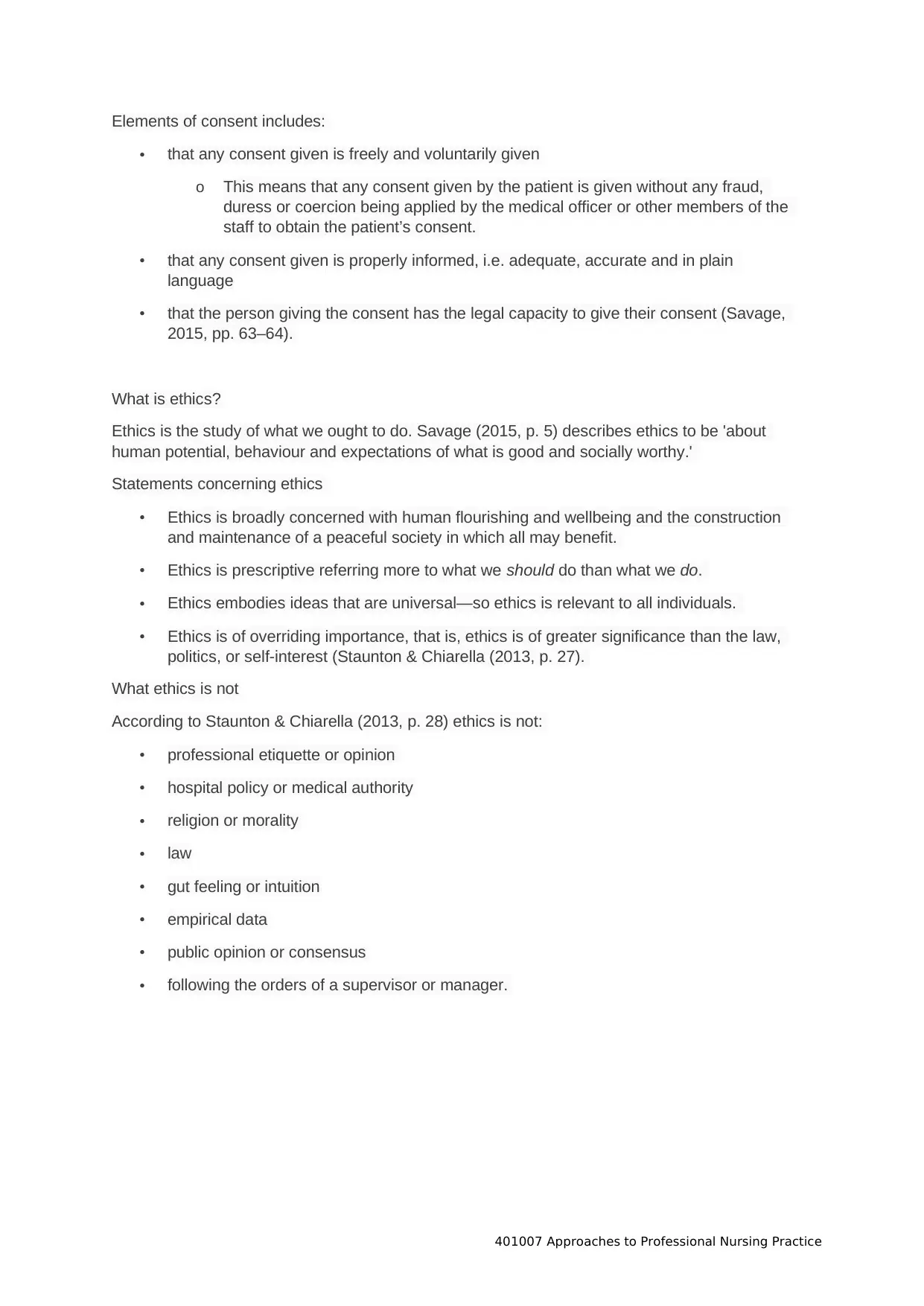
401007 Approaches to Professional Nursing Practice
Elements of consent includes:
• that any consent given is freely and voluntarily given
o This means that any consent given by the patient is given without any fraud,
duress or coercion being applied by the medical officer or other members of the
staff to obtain the patient’s consent.
• that any consent given is properly informed, i.e. adequate, accurate and in plain
language
• that the person giving the consent has the legal capacity to give their consent (Savage,
2015, pp. 63–64).
What is ethics?
Ethics is the study of what we ought to do. Savage (2015, p. 5) describes ethics to be 'about
human potential, behaviour and expectations of what is good and socially worthy.'
Statements concerning ethics
• Ethics is broadly concerned with human flourishing and wellbeing and the construction
and maintenance of a peaceful society in which all may benefit.
• Ethics is prescriptive referring more to what we should do than what we do.
• Ethics embodies ideas that are universal—so ethics is relevant to all individuals.
• Ethics is of overriding importance, that is, ethics is of greater significance than the law,
politics, or self-interest (Staunton & Chiarella (2013, p. 27).
What ethics is not
According to Staunton & Chiarella (2013, p. 28) ethics is not:
• professional etiquette or opinion
• hospital policy or medical authority
• religion or morality
• law
• gut feeling or intuition
• empirical data
• public opinion or consensus
• following the orders of a supervisor or manager.
Elements of consent includes:
• that any consent given is freely and voluntarily given
o This means that any consent given by the patient is given without any fraud,
duress or coercion being applied by the medical officer or other members of the
staff to obtain the patient’s consent.
• that any consent given is properly informed, i.e. adequate, accurate and in plain
language
• that the person giving the consent has the legal capacity to give their consent (Savage,
2015, pp. 63–64).
What is ethics?
Ethics is the study of what we ought to do. Savage (2015, p. 5) describes ethics to be 'about
human potential, behaviour and expectations of what is good and socially worthy.'
Statements concerning ethics
• Ethics is broadly concerned with human flourishing and wellbeing and the construction
and maintenance of a peaceful society in which all may benefit.
• Ethics is prescriptive referring more to what we should do than what we do.
• Ethics embodies ideas that are universal—so ethics is relevant to all individuals.
• Ethics is of overriding importance, that is, ethics is of greater significance than the law,
politics, or self-interest (Staunton & Chiarella (2013, p. 27).
What ethics is not
According to Staunton & Chiarella (2013, p. 28) ethics is not:
• professional etiquette or opinion
• hospital policy or medical authority
• religion or morality
• law
• gut feeling or intuition
• empirical data
• public opinion or consensus
• following the orders of a supervisor or manager.
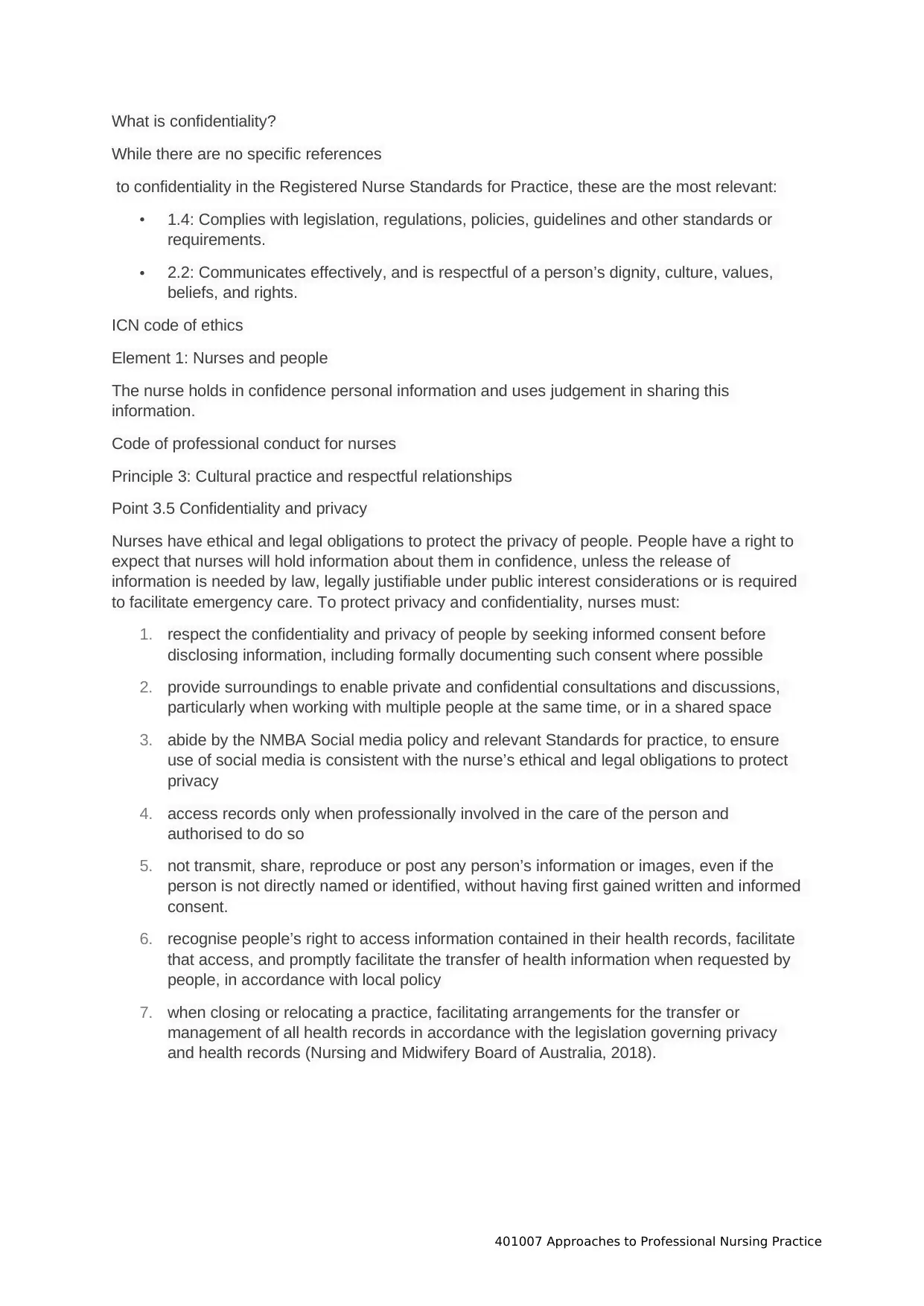
401007 Approaches to Professional Nursing Practice
What is confidentiality?
While there are no specific references
to confidentiality in the Registered Nurse Standards for Practice, these are the most relevant:
• 1.4: Complies with legislation, regulations, policies, guidelines and other standards or
requirements.
• 2.2: Communicates effectively, and is respectful of a person’s dignity, culture, values,
beliefs, and rights.
ICN code of ethics
Element 1: Nurses and people
The nurse holds in confidence personal information and uses judgement in sharing this
information.
Code of professional conduct for nurses
Principle 3: Cultural practice and respectful relationships
Point 3.5 Confidentiality and privacy
Nurses have ethical and legal obligations to protect the privacy of people. People have a right to
expect that nurses will hold information about them in confidence, unless the release of
information is needed by law, legally justifiable under public interest considerations or is required
to facilitate emergency care. To protect privacy and confidentiality, nurses must:
1. respect the confidentiality and privacy of people by seeking informed consent before
disclosing information, including formally documenting such consent where possible
2. provide surroundings to enable private and confidential consultations and discussions,
particularly when working with multiple people at the same time, or in a shared space
3. abide by the NMBA Social media policy and relevant Standards for practice, to ensure
use of social media is consistent with the nurse’s ethical and legal obligations to protect
privacy
4. access records only when professionally involved in the care of the person and
authorised to do so
5. not transmit, share, reproduce or post any person’s information or images, even if the
person is not directly named or identified, without having first gained written and informed
consent.
6. recognise people’s right to access information contained in their health records, facilitate
that access, and promptly facilitate the transfer of health information when requested by
people, in accordance with local policy
7. when closing or relocating a practice, facilitating arrangements for the transfer or
management of all health records in accordance with the legislation governing privacy
and health records (Nursing and Midwifery Board of Australia, 2018).
What is confidentiality?
While there are no specific references
to confidentiality in the Registered Nurse Standards for Practice, these are the most relevant:
• 1.4: Complies with legislation, regulations, policies, guidelines and other standards or
requirements.
• 2.2: Communicates effectively, and is respectful of a person’s dignity, culture, values,
beliefs, and rights.
ICN code of ethics
Element 1: Nurses and people
The nurse holds in confidence personal information and uses judgement in sharing this
information.
Code of professional conduct for nurses
Principle 3: Cultural practice and respectful relationships
Point 3.5 Confidentiality and privacy
Nurses have ethical and legal obligations to protect the privacy of people. People have a right to
expect that nurses will hold information about them in confidence, unless the release of
information is needed by law, legally justifiable under public interest considerations or is required
to facilitate emergency care. To protect privacy and confidentiality, nurses must:
1. respect the confidentiality and privacy of people by seeking informed consent before
disclosing information, including formally documenting such consent where possible
2. provide surroundings to enable private and confidential consultations and discussions,
particularly when working with multiple people at the same time, or in a shared space
3. abide by the NMBA Social media policy and relevant Standards for practice, to ensure
use of social media is consistent with the nurse’s ethical and legal obligations to protect
privacy
4. access records only when professionally involved in the care of the person and
authorised to do so
5. not transmit, share, reproduce or post any person’s information or images, even if the
person is not directly named or identified, without having first gained written and informed
consent.
6. recognise people’s right to access information contained in their health records, facilitate
that access, and promptly facilitate the transfer of health information when requested by
people, in accordance with local policy
7. when closing or relocating a practice, facilitating arrangements for the transfer or
management of all health records in accordance with the legislation governing privacy
and health records (Nursing and Midwifery Board of Australia, 2018).
⊘ This is a preview!⊘
Do you want full access?
Subscribe today to unlock all pages.

Trusted by 1+ million students worldwide
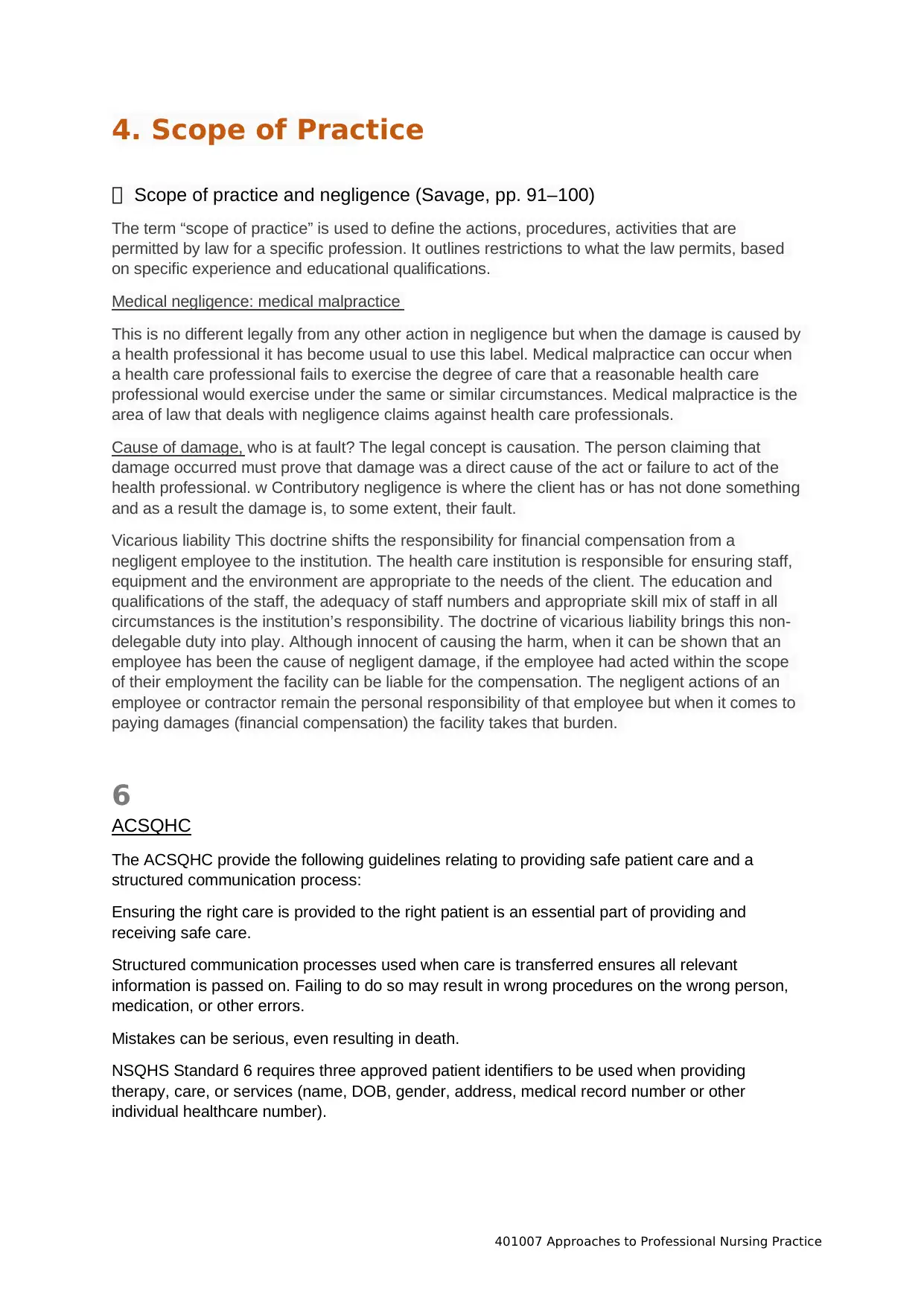
401007 Approaches to Professional Nursing Practice
4. Scope of Practice
Scope of practice and negligence (Savage, pp. 91–100)
The term “scope of practice” is used to define the actions, procedures, activities that are
permitted by law for a specific profession. It outlines restrictions to what the law permits, based
on specific experience and educational qualifications.
Medical negligence: medical malpractice
This is no different legally from any other action in negligence but when the damage is caused by
a health professional it has become usual to use this label. Medical malpractice can occur when
a health care professional fails to exercise the degree of care that a reasonable health care
professional would exercise under the same or similar circumstances. Medical malpractice is the
area of law that deals with negligence claims against health care professionals.
Cause of damage, who is at fault? The legal concept is causation. The person claiming that
damage occurred must prove that damage was a direct cause of the act or failure to act of the
health professional. w Contributory negligence is where the client has or has not done something
and as a result the damage is, to some extent, their fault.
Vicarious liability This doctrine shifts the responsibility for financial compensation from a
negligent employee to the institution. The health care institution is responsible for ensuring staff,
equipment and the environment are appropriate to the needs of the client. The education and
qualifications of the staff, the adequacy of staff numbers and appropriate skill mix of staff in all
circumstances is the institution’s responsibility. The doctrine of vicarious liability brings this non-
delegable duty into play. Although innocent of causing the harm, when it can be shown that an
employee has been the cause of negligent damage, if the employee had acted within the scope
of their employment the facility can be liable for the compensation. The negligent actions of an
employee or contractor remain the personal responsibility of that employee but when it comes to
paying damages (financial compensation) the facility takes that burden.
6
ACSQHC
The ACSQHC provide the following guidelines relating to providing safe patient care and a
structured communication process:
Ensuring the right care is provided to the right patient is an essential part of providing and
receiving safe care.
Structured communication processes used when care is transferred ensures all relevant
information is passed on. Failing to do so may result in wrong procedures on the wrong person,
medication, or other errors.
Mistakes can be serious, even resulting in death.
NSQHS Standard 6 requires three approved patient identifiers to be used when providing
therapy, care, or services (name, DOB, gender, address, medical record number or other
individual healthcare number).
4. Scope of Practice
Scope of practice and negligence (Savage, pp. 91–100)
The term “scope of practice” is used to define the actions, procedures, activities that are
permitted by law for a specific profession. It outlines restrictions to what the law permits, based
on specific experience and educational qualifications.
Medical negligence: medical malpractice
This is no different legally from any other action in negligence but when the damage is caused by
a health professional it has become usual to use this label. Medical malpractice can occur when
a health care professional fails to exercise the degree of care that a reasonable health care
professional would exercise under the same or similar circumstances. Medical malpractice is the
area of law that deals with negligence claims against health care professionals.
Cause of damage, who is at fault? The legal concept is causation. The person claiming that
damage occurred must prove that damage was a direct cause of the act or failure to act of the
health professional. w Contributory negligence is where the client has or has not done something
and as a result the damage is, to some extent, their fault.
Vicarious liability This doctrine shifts the responsibility for financial compensation from a
negligent employee to the institution. The health care institution is responsible for ensuring staff,
equipment and the environment are appropriate to the needs of the client. The education and
qualifications of the staff, the adequacy of staff numbers and appropriate skill mix of staff in all
circumstances is the institution’s responsibility. The doctrine of vicarious liability brings this non-
delegable duty into play. Although innocent of causing the harm, when it can be shown that an
employee has been the cause of negligent damage, if the employee had acted within the scope
of their employment the facility can be liable for the compensation. The negligent actions of an
employee or contractor remain the personal responsibility of that employee but when it comes to
paying damages (financial compensation) the facility takes that burden.
6
ACSQHC
The ACSQHC provide the following guidelines relating to providing safe patient care and a
structured communication process:
Ensuring the right care is provided to the right patient is an essential part of providing and
receiving safe care.
Structured communication processes used when care is transferred ensures all relevant
information is passed on. Failing to do so may result in wrong procedures on the wrong person,
medication, or other errors.
Mistakes can be serious, even resulting in death.
NSQHS Standard 6 requires three approved patient identifiers to be used when providing
therapy, care, or services (name, DOB, gender, address, medical record number or other
individual healthcare number).
Paraphrase This Document
Need a fresh take? Get an instant paraphrase of this document with our AI Paraphraser
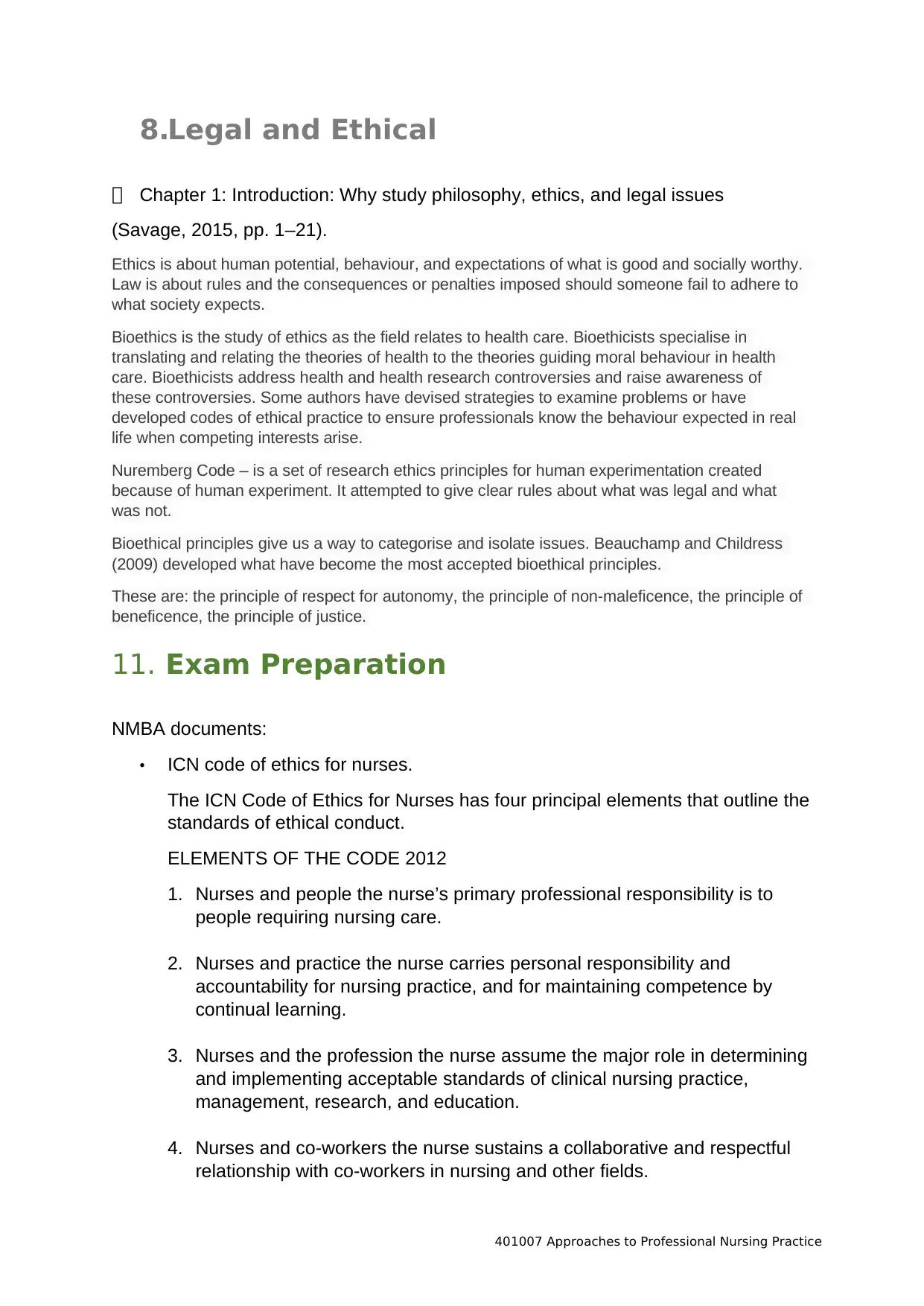
401007 Approaches to Professional Nursing Practice
8.Legal and Ethical
Chapter 1: Introduction: Why study philosophy, ethics, and legal issues
(Savage, 2015, pp. 1–21).
Ethics is about human potential, behaviour, and expectations of what is good and socially worthy.
Law is about rules and the consequences or penalties imposed should someone fail to adhere to
what society expects.
Bioethics is the study of ethics as the field relates to health care. Bioethicists specialise in
translating and relating the theories of health to the theories guiding moral behaviour in health
care. Bioethicists address health and health research controversies and raise awareness of
these controversies. Some authors have devised strategies to examine problems or have
developed codes of ethical practice to ensure professionals know the behaviour expected in real
life when competing interests arise.
Nuremberg Code – is a set of research ethics principles for human experimentation created
because of human experiment. It attempted to give clear rules about what was legal and what
was not.
Bioethical principles give us a way to categorise and isolate issues. Beauchamp and Childress
(2009) developed what have become the most accepted bioethical principles.
These are: the principle of respect for autonomy, the principle of non-maleficence, the principle of
beneficence, the principle of justice.
11. Exam Preparation
NMBA documents:
• ICN code of ethics for nurses.
The ICN Code of Ethics for Nurses has four principal elements that outline the
standards of ethical conduct.
ELEMENTS OF THE CODE 2012
1. Nurses and people the nurse’s primary professional responsibility is to
people requiring nursing care.
2. Nurses and practice the nurse carries personal responsibility and
accountability for nursing practice, and for maintaining competence by
continual learning.
3. Nurses and the profession the nurse assume the major role in determining
and implementing acceptable standards of clinical nursing practice,
management, research, and education.
4. Nurses and co-workers the nurse sustains a collaborative and respectful
relationship with co-workers in nursing and other fields.
8.Legal and Ethical
Chapter 1: Introduction: Why study philosophy, ethics, and legal issues
(Savage, 2015, pp. 1–21).
Ethics is about human potential, behaviour, and expectations of what is good and socially worthy.
Law is about rules and the consequences or penalties imposed should someone fail to adhere to
what society expects.
Bioethics is the study of ethics as the field relates to health care. Bioethicists specialise in
translating and relating the theories of health to the theories guiding moral behaviour in health
care. Bioethicists address health and health research controversies and raise awareness of
these controversies. Some authors have devised strategies to examine problems or have
developed codes of ethical practice to ensure professionals know the behaviour expected in real
life when competing interests arise.
Nuremberg Code – is a set of research ethics principles for human experimentation created
because of human experiment. It attempted to give clear rules about what was legal and what
was not.
Bioethical principles give us a way to categorise and isolate issues. Beauchamp and Childress
(2009) developed what have become the most accepted bioethical principles.
These are: the principle of respect for autonomy, the principle of non-maleficence, the principle of
beneficence, the principle of justice.
11. Exam Preparation
NMBA documents:
• ICN code of ethics for nurses.
The ICN Code of Ethics for Nurses has four principal elements that outline the
standards of ethical conduct.
ELEMENTS OF THE CODE 2012
1. Nurses and people the nurse’s primary professional responsibility is to
people requiring nursing care.
2. Nurses and practice the nurse carries personal responsibility and
accountability for nursing practice, and for maintaining competence by
continual learning.
3. Nurses and the profession the nurse assume the major role in determining
and implementing acceptable standards of clinical nursing practice,
management, research, and education.
4. Nurses and co-workers the nurse sustains a collaborative and respectful
relationship with co-workers in nursing and other fields.
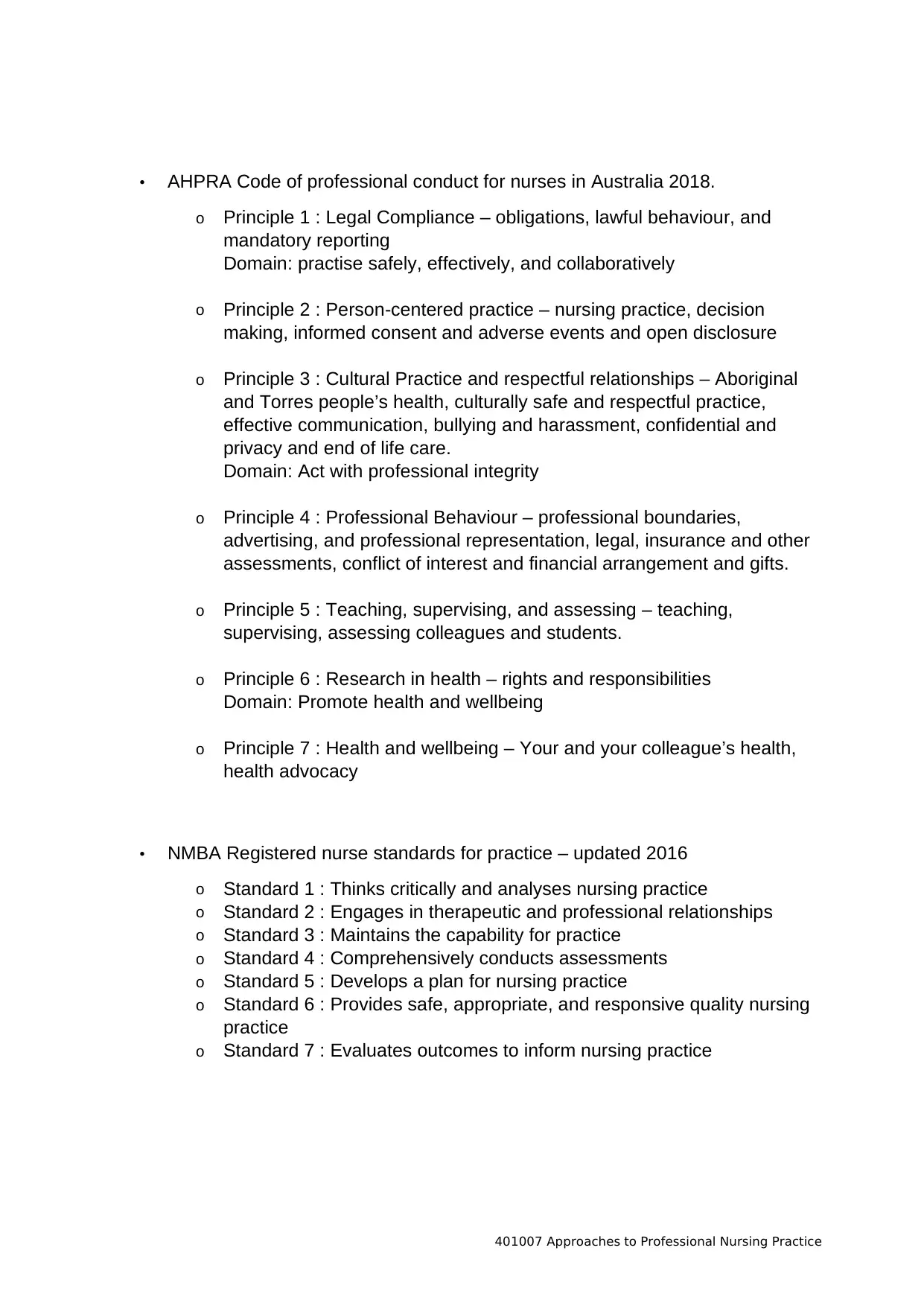
401007 Approaches to Professional Nursing Practice
• AHPRA Code of professional conduct for nurses in Australia 2018.
o Principle 1 : Legal Compliance – obligations, lawful behaviour, and
mandatory reporting
Domain: practise safely, effectively, and collaboratively
o Principle 2 : Person-centered practice – nursing practice, decision
making, informed consent and adverse events and open disclosure
o Principle 3 : Cultural Practice and respectful relationships – Aboriginal
and Torres people’s health, culturally safe and respectful practice,
effective communication, bullying and harassment, confidential and
privacy and end of life care.
Domain: Act with professional integrity
o Principle 4 : Professional Behaviour – professional boundaries,
advertising, and professional representation, legal, insurance and other
assessments, conflict of interest and financial arrangement and gifts.
o Principle 5 : Teaching, supervising, and assessing – teaching,
supervising, assessing colleagues and students.
o Principle 6 : Research in health – rights and responsibilities
Domain: Promote health and wellbeing
o Principle 7 : Health and wellbeing – Your and your colleague’s health,
health advocacy
• NMBA Registered nurse standards for practice – updated 2016
o Standard 1 : Thinks critically and analyses nursing practice
o Standard 2 : Engages in therapeutic and professional relationships
o Standard 3 : Maintains the capability for practice
o Standard 4 : Comprehensively conducts assessments
o Standard 5 : Develops a plan for nursing practice
o Standard 6 : Provides safe, appropriate, and responsive quality nursing
practice
o Standard 7 : Evaluates outcomes to inform nursing practice
• AHPRA Code of professional conduct for nurses in Australia 2018.
o Principle 1 : Legal Compliance – obligations, lawful behaviour, and
mandatory reporting
Domain: practise safely, effectively, and collaboratively
o Principle 2 : Person-centered practice – nursing practice, decision
making, informed consent and adverse events and open disclosure
o Principle 3 : Cultural Practice and respectful relationships – Aboriginal
and Torres people’s health, culturally safe and respectful practice,
effective communication, bullying and harassment, confidential and
privacy and end of life care.
Domain: Act with professional integrity
o Principle 4 : Professional Behaviour – professional boundaries,
advertising, and professional representation, legal, insurance and other
assessments, conflict of interest and financial arrangement and gifts.
o Principle 5 : Teaching, supervising, and assessing – teaching,
supervising, assessing colleagues and students.
o Principle 6 : Research in health – rights and responsibilities
Domain: Promote health and wellbeing
o Principle 7 : Health and wellbeing – Your and your colleague’s health,
health advocacy
• NMBA Registered nurse standards for practice – updated 2016
o Standard 1 : Thinks critically and analyses nursing practice
o Standard 2 : Engages in therapeutic and professional relationships
o Standard 3 : Maintains the capability for practice
o Standard 4 : Comprehensively conducts assessments
o Standard 5 : Develops a plan for nursing practice
o Standard 6 : Provides safe, appropriate, and responsive quality nursing
practice
o Standard 7 : Evaluates outcomes to inform nursing practice
⊘ This is a preview!⊘
Do you want full access?
Subscribe today to unlock all pages.

Trusted by 1+ million students worldwide
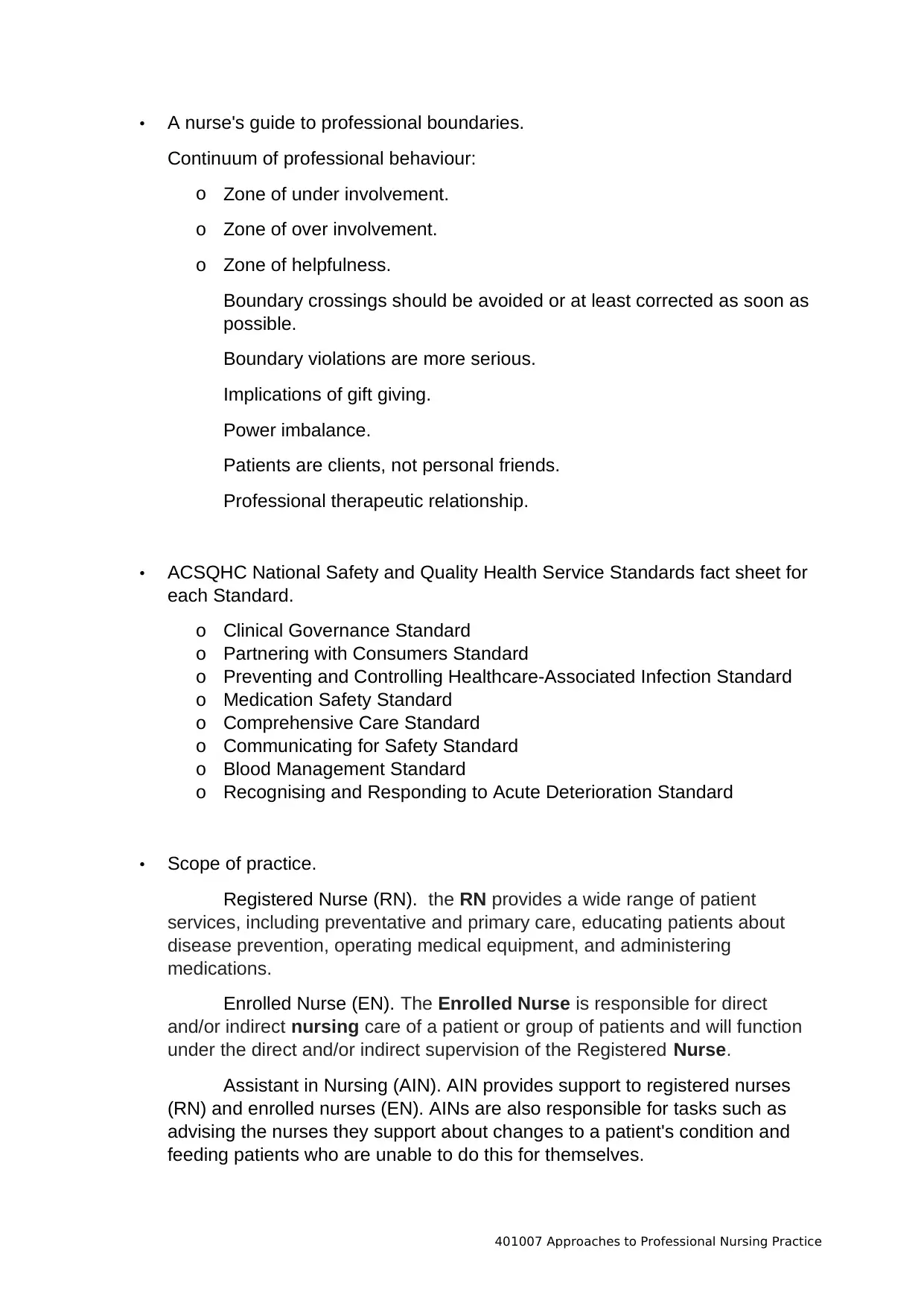
401007 Approaches to Professional Nursing Practice
• A nurse's guide to professional boundaries.
Continuum of professional behaviour:
o Zone of under involvement.
o Zone of over involvement.
o Zone of helpfulness.
Boundary crossings should be avoided or at least corrected as soon as
possible.
Boundary violations are more serious.
Implications of gift giving.
Power imbalance.
Patients are clients, not personal friends.
Professional therapeutic relationship.
• ACSQHC National Safety and Quality Health Service Standards fact sheet for
each Standard.
o Clinical Governance Standard
o Partnering with Consumers Standard
o Preventing and Controlling Healthcare-Associated Infection Standard
o Medication Safety Standard
o Comprehensive Care Standard
o Communicating for Safety Standard
o Blood Management Standard
o Recognising and Responding to Acute Deterioration Standard
• Scope of practice.
Registered Nurse (RN). the RN provides a wide range of patient
services, including preventative and primary care, educating patients about
disease prevention, operating medical equipment, and administering
medications.
Enrolled Nurse (EN). The Enrolled Nurse is responsible for direct
and/or indirect nursing care of a patient or group of patients and will function
under the direct and/or indirect supervision of the Registered Nurse.
Assistant in Nursing (AIN). AIN provides support to registered nurses
(RN) and enrolled nurses (EN). AINs are also responsible for tasks such as
advising the nurses they support about changes to a patient's condition and
feeding patients who are unable to do this for themselves.
• A nurse's guide to professional boundaries.
Continuum of professional behaviour:
o Zone of under involvement.
o Zone of over involvement.
o Zone of helpfulness.
Boundary crossings should be avoided or at least corrected as soon as
possible.
Boundary violations are more serious.
Implications of gift giving.
Power imbalance.
Patients are clients, not personal friends.
Professional therapeutic relationship.
• ACSQHC National Safety and Quality Health Service Standards fact sheet for
each Standard.
o Clinical Governance Standard
o Partnering with Consumers Standard
o Preventing and Controlling Healthcare-Associated Infection Standard
o Medication Safety Standard
o Comprehensive Care Standard
o Communicating for Safety Standard
o Blood Management Standard
o Recognising and Responding to Acute Deterioration Standard
• Scope of practice.
Registered Nurse (RN). the RN provides a wide range of patient
services, including preventative and primary care, educating patients about
disease prevention, operating medical equipment, and administering
medications.
Enrolled Nurse (EN). The Enrolled Nurse is responsible for direct
and/or indirect nursing care of a patient or group of patients and will function
under the direct and/or indirect supervision of the Registered Nurse.
Assistant in Nursing (AIN). AIN provides support to registered nurses
(RN) and enrolled nurses (EN). AINs are also responsible for tasks such as
advising the nurses they support about changes to a patient's condition and
feeding patients who are unable to do this for themselves.
Paraphrase This Document
Need a fresh take? Get an instant paraphrase of this document with our AI Paraphraser
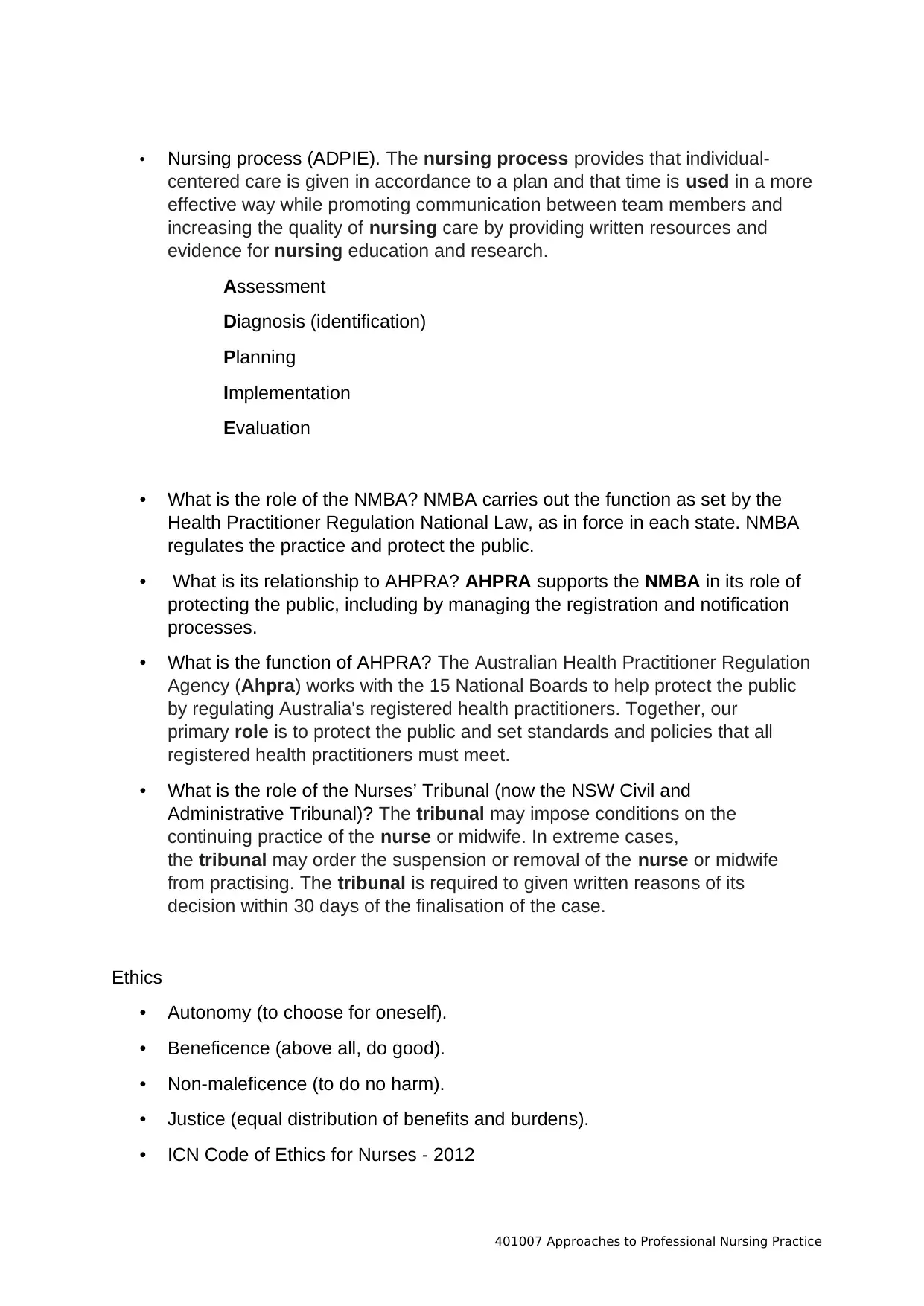
401007 Approaches to Professional Nursing Practice
• Nursing process (ADPIE). The nursing process provides that individual-
centered care is given in accordance to a plan and that time is used in a more
effective way while promoting communication between team members and
increasing the quality of nursing care by providing written resources and
evidence for nursing education and research.
Assessment
Diagnosis (identification)
Planning
Implementation
Evaluation
• What is the role of the NMBA? NMBA carries out the function as set by the
Health Practitioner Regulation National Law, as in force in each state. NMBA
regulates the practice and protect the public.
• What is its relationship to AHPRA? AHPRA supports the NMBA in its role of
protecting the public, including by managing the registration and notification
processes.
• What is the function of AHPRA? The Australian Health Practitioner Regulation
Agency (Ahpra) works with the 15 National Boards to help protect the public
by regulating Australia's registered health practitioners. Together, our
primary role is to protect the public and set standards and policies that all
registered health practitioners must meet.
• What is the role of the Nurses’ Tribunal (now the NSW Civil and
Administrative Tribunal)? The tribunal may impose conditions on the
continuing practice of the nurse or midwife. In extreme cases,
the tribunal may order the suspension or removal of the nurse or midwife
from practising. The tribunal is required to given written reasons of its
decision within 30 days of the finalisation of the case.
Ethics
• Autonomy (to choose for oneself).
• Beneficence (above all, do good).
• Non-maleficence (to do no harm).
• Justice (equal distribution of benefits and burdens).
• ICN Code of Ethics for Nurses - 2012
• Nursing process (ADPIE). The nursing process provides that individual-
centered care is given in accordance to a plan and that time is used in a more
effective way while promoting communication between team members and
increasing the quality of nursing care by providing written resources and
evidence for nursing education and research.
Assessment
Diagnosis (identification)
Planning
Implementation
Evaluation
• What is the role of the NMBA? NMBA carries out the function as set by the
Health Practitioner Regulation National Law, as in force in each state. NMBA
regulates the practice and protect the public.
• What is its relationship to AHPRA? AHPRA supports the NMBA in its role of
protecting the public, including by managing the registration and notification
processes.
• What is the function of AHPRA? The Australian Health Practitioner Regulation
Agency (Ahpra) works with the 15 National Boards to help protect the public
by regulating Australia's registered health practitioners. Together, our
primary role is to protect the public and set standards and policies that all
registered health practitioners must meet.
• What is the role of the Nurses’ Tribunal (now the NSW Civil and
Administrative Tribunal)? The tribunal may impose conditions on the
continuing practice of the nurse or midwife. In extreme cases,
the tribunal may order the suspension or removal of the nurse or midwife
from practising. The tribunal is required to given written reasons of its
decision within 30 days of the finalisation of the case.
Ethics
• Autonomy (to choose for oneself).
• Beneficence (above all, do good).
• Non-maleficence (to do no harm).
• Justice (equal distribution of benefits and burdens).
• ICN Code of Ethics for Nurses - 2012
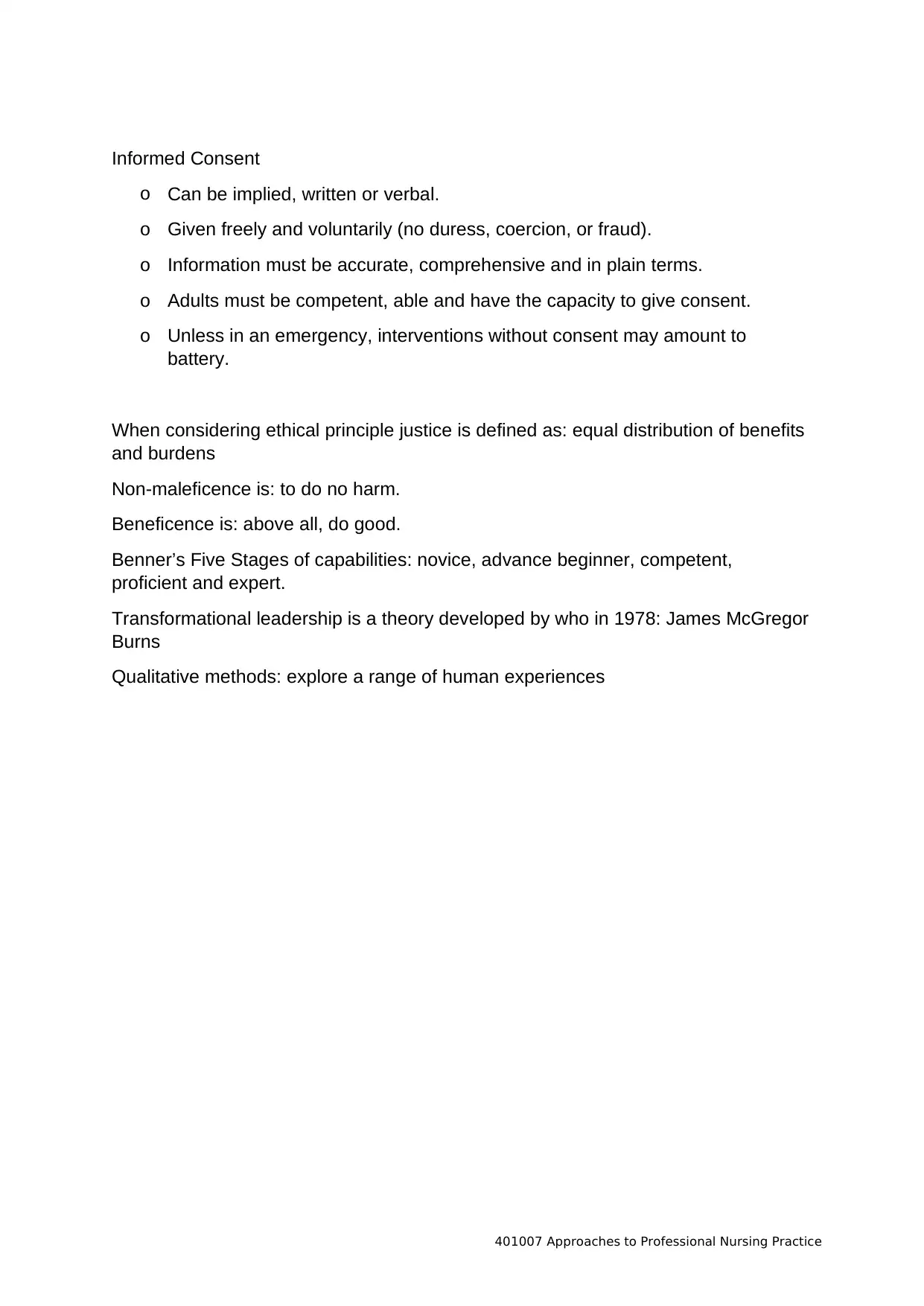
401007 Approaches to Professional Nursing Practice
Informed Consent
o Can be implied, written or verbal.
o Given freely and voluntarily (no duress, coercion, or fraud).
o Information must be accurate, comprehensive and in plain terms.
o Adults must be competent, able and have the capacity to give consent.
o Unless in an emergency, interventions without consent may amount to
battery.
When considering ethical principle justice is defined as: equal distribution of benefits
and burdens
Non-maleficence is: to do no harm.
Beneficence is: above all, do good.
Benner’s Five Stages of capabilities: novice, advance beginner, competent,
proficient and expert.
Transformational leadership is a theory developed by who in 1978: James McGregor
Burns
Qualitative methods: explore a range of human experiences
Informed Consent
o Can be implied, written or verbal.
o Given freely and voluntarily (no duress, coercion, or fraud).
o Information must be accurate, comprehensive and in plain terms.
o Adults must be competent, able and have the capacity to give consent.
o Unless in an emergency, interventions without consent may amount to
battery.
When considering ethical principle justice is defined as: equal distribution of benefits
and burdens
Non-maleficence is: to do no harm.
Beneficence is: above all, do good.
Benner’s Five Stages of capabilities: novice, advance beginner, competent,
proficient and expert.
Transformational leadership is a theory developed by who in 1978: James McGregor
Burns
Qualitative methods: explore a range of human experiences
⊘ This is a preview!⊘
Do you want full access?
Subscribe today to unlock all pages.

Trusted by 1+ million students worldwide
1 out of 12
Related Documents
Your All-in-One AI-Powered Toolkit for Academic Success.
+13062052269
info@desklib.com
Available 24*7 on WhatsApp / Email
![[object Object]](/_next/static/media/star-bottom.7253800d.svg)
Unlock your academic potential
Copyright © 2020–2025 A2Z Services. All Rights Reserved. Developed and managed by ZUCOL.





